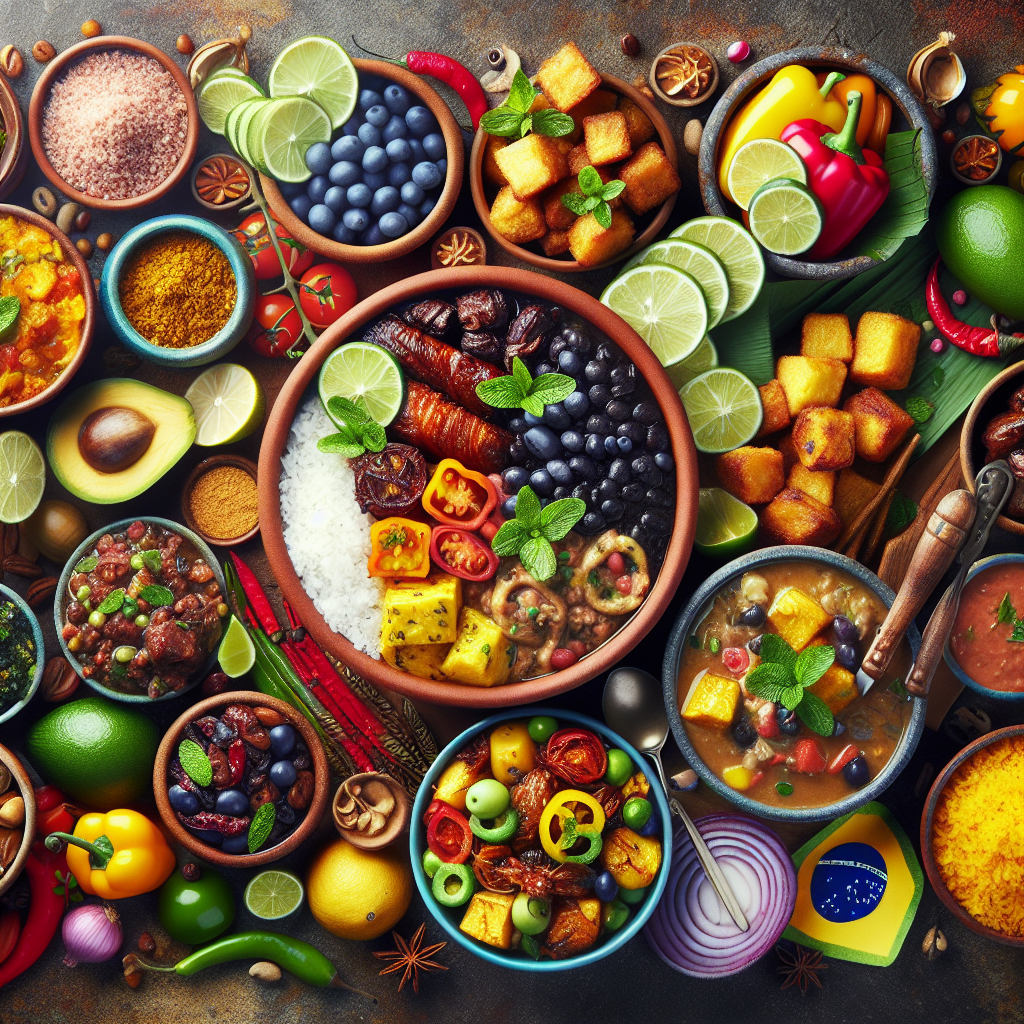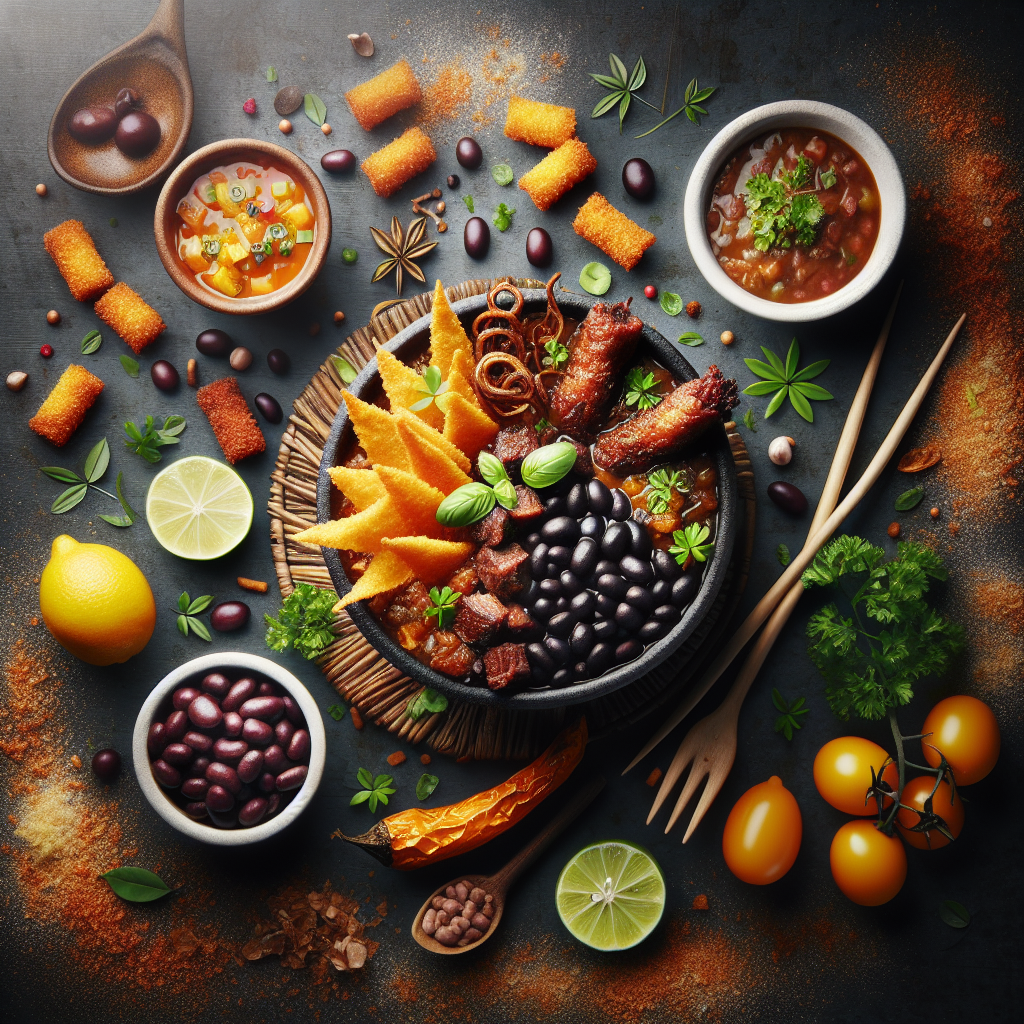If you’re looking to savor the true flavors of Brazil, then it’s time to embark on a culinary adventure like no other. Explore the vibrant and diverse gastronomy of this mesmerizing country by indulging in a classic Brazilian dish that is as authentic as it gets. From the tropical coastlines to the bustling city streets, every bite of this traditional delicacy will transport your taste buds to the heart and soul of Brazil, leaving you craving for more. So, whether you’re a food enthusiast searching for a new culinary experience or simply curious about the vibrant Brazilian culture, let us guide you to the perfect dish that will capture the essence of this captivating country.

History of Brazilian Cuisine
Colonial Era
During the Colonial Era, Portuguese explorers arrived in Brazil in the 16th century and brought with them their traditional dishes and cooking techniques. This marked the beginning of a culinary blend that would shape Brazilian cuisine. The Portuguese introduced ingredients like wheat, wine, and olive oil, which were previously unknown in the region. They also brought over their love for sweet pastries and the art of baking. As a result, Brazilian cuisine began to incorporate elements of Portuguese cuisine while still maintaining its own unique flavors.
African Influence
Another significant influence on Brazilian cuisine came from the African slaves who were brought to Brazil during the colonial era. Forced to work on plantations, these slaves brought their own culinary traditions and techniques, infusing Brazilian cuisine with a vibrant African influence. They introduced ingredients like palm oil, okra, and different spices that are commonly used in Brazilian dishes today. The African influence is particularly notable in the cuisine of the northeastern region of Brazil, where many traditional dishes have strong African roots.
Indigenous Influence
The indigenous peoples of Brazil also played a crucial role in shaping Brazilian cuisine. Prior to the arrival of the Europeans, the indigenous tribes had their own rich culinary traditions. They utilized a wide variety of ingredients from the Amazon rainforest, such as manioc, cassava, and various fruits and nuts. The indigenous influence can be seen in dishes like tacacá, a traditional soup made with shrimp, jambu leaves, and manioc flour, which remains popular in the northern region of Brazil. The blending of indigenous, Portuguese, and African influences laid the foundation for the diverse and vibrant flavors that define Brazilian cuisine.
Brazilian Cuisine: A Fusion of Flavors
Regional Diversity
One of the most intriguing aspects of Brazilian cuisine is its regional diversity. The vast size of the country coupled with its rich cultural heritage has given rise to a remarkable array of flavors and culinary traditions. Each region of Brazil offers its own unique specialties, reflecting the influence of its history, geography, and local ingredients. From the rich seafood dishes of the coastal areas to the hearty stews and roasted meats of the interior, Brazilian cuisine encompasses a wide range of flavors and culinary techniques.
Use of Ingredients
Brazilian cuisine takes advantage of the country’s abundant natural resources and diverse ecosystems. The use of fresh and locally sourced ingredients is a fundamental aspect of Brazilian cooking. Fruits such as acai, passion fruit, and guava are commonly used in desserts and drinks, adding a distinct tropical twist to many dishes. Staples like rice, beans, and cassava form the foundation of many Brazilian meals, providing a substantial and nourishing base. Meat, especially beef, holds a special place in Brazilian cuisine, with dishes like churrasco (barbecue) showcasing the country’s passion for grilling and meat preparation.
Traditional Cooking Techniques
Traditional cooking techniques are an integral part of Brazilian cuisine, showcasing the skill and creativity of the country’s cooks and chefs. From slow-cooking in clay pots to grilling over open flames, Brazilian dishes often require time and patience to achieve the perfect balance of flavors. Curing and marinating, as well as the use of indigenous herbs and spices, contribute to the distinctive taste profiles of many traditional Brazilian dishes. These techniques have been passed down through generations, preserving the cultural heritage and authenticity of Brazilian cuisine.
Feijoada: The National Dish of Brazil
Origin and Significance
Feijoada, often considered the national dish of Brazil, has its origins in the time of slavery. It was created by the African slaves who would gather the leftover cuts of meat from their masters’ meals and combine them with black beans. Over time, the dish evolved into a hearty stew that is now an integral part of Brazilian culinary culture. Feijoada typically consists of black beans cooked slowly with various cuts of pork, including pork belly, sausage, and beef jerky. It is a dish that symbolizes unity and shared heritage, reflecting the blending of cultures that defines Brazil.
Ingredients and Preparation
The key ingredients of feijoada are black beans and a variety of pork products. The black beans are soaked overnight and then cooked slowly until they are tender and creamy. The different cuts of pork are added during the cooking process to infuse the dish with rich flavors. The meats are often smoked or cured, adding depth and complexity to the stew. Feijoada is typically seasoned with garlic, onions, and bay leaves, as well as traditional Brazilian spices like cumin and paprika. The long cooking time allows the flavors to meld together, resulting in a delicious and satisfying dish.
Accompaniments
Feijoada is traditionally served with a variety of accompaniments that complement its flavors. These may include white rice, collard greens sautéed with garlic, farofa (toasted manioc flour), and orange slices. The acidity from the oranges helps cut through the richness of the stew, while the farofa adds a crunchy texture. Feijoada is often enjoyed in a social setting, with family and friends gathering around the table to share a meal and celebrate Brazilian culture.
Moqueca: A Taste of the Coast
Traditional Moqueca
Moqueca is a traditional Brazilian seafood stew that originated in the coastal regions of Brazil. It is a vibrant and flavorful dish that showcases the country’s love for fresh seafood and bold seasonings. Moqueca can be made with various types of seafood, such as fish, shrimp, and mussels, and is typically cooked with tomatoes, onions, garlic, cilantro, and coconut milk. The stew is slow-cooked in a clay pot, allowing the flavors to meld together and create a rich and aromatic broth.
Ingredients and Seasonings
The key ingredients in moqueca are seafood and coconut milk. The seafood can vary depending on the region and availability, but it is always the star of the dish. The use of coconut milk adds a creamy and slightly sweet element to the stew, balancing out the acidity of the tomatoes and the heat from the spices. Traditional seasonings for moqueca include dendê oil, which is derived from palm fruit, as well as cilantro, garlic, and onions. These seasonings create a bold and aromatic flavor profile that is characteristic of Brazilian cuisine.
Preparation Techniques
Moqueca is traditionally cooked in a clay pot, which helps to retain and distribute heat evenly. The slow cooking process allows the flavors to develop and intensify, resulting in a deeply satisfying stew. The dish is often served with white rice and farofa, as well as a sprinkle of fresh cilantro on top for added freshness. Moqueca is a classic example of the coastal flavors of Brazil, showcasing the country’s abundance of fresh seafood and its passion for bold and vibrant seasonings.

Acarajé: A Culinary Delight from Bahia
Introduction to Acarajé
Acarajé is a popular street food from the northeastern state of Bahia. It is a deep-fried ball made from black-eyed peas, filled with a flavorful mixture of shrimp, vatapá (a spicy paste made from bread, shrimp, and various spices), and caruru (a sauce made from okra and palm oil). Acarajé has its roots in the African traditions brought over by the slaves, and it has become an iconic dish in Bahian cuisine. It is often sold by women known as baianas, who dress in traditional white attire and carry trays of acarajé on their heads.
Ingredients and Fillings
The main ingredient in acarajé is black-eyed peas, which are ground into a paste and mixed with onion and salt before being shaped into balls. The balls are then deep-fried until they are golden and crispy on the outside, while remaining soft and fluffy on the inside. The filling is what gives acarajé its unique flavors. It typically consists of shrimp, vatapá, and caruru. The shrimp are often sautéed with garlic and spices before being added to the acarajé, while the vatapá and caruru provide a spicy and aromatic element to the dish.
Street Food Culture
Acarajé is not just a delicious snack, but also a symbol of the vibrant street food culture in Brazil. In the bustling streets of Bahia, you can find baianas selling acarajé from improvised food stalls, where they skillfully assemble the balls and fill them with the flavorful mixture. The aroma of frying acarajé wafts through the air, enticing locals and visitors alike to indulge in this culinary delight. Acarajé is best enjoyed hot and fresh, straight from the baiana’s tray, perfectly capturing the essence of Bahian street food culture.
Pão de Queijo: Cheesy Goodness
Origins of Pão de Queijo
Pão de Queijo, which translates to “cheese bread” in English, is a beloved Brazilian snack that originated in the state of Minas Gerais. It is a small, round bread roll made from tapioca flour and cheese, usually parmesan or minas cheese. Pão de Queijo has its roots in the indigenous traditions of Brazil, as tapioca flour is derived from cassava, a staple crop for many indigenous tribes. Over time, the recipe for pão de queijo evolved to incorporate European influences, particularly the use of cheese brought over by the Portuguese.
Key Ingredients and Preparation
The key ingredients in pão de queijo are tapioca flour, cheese, eggs, and milk. Tapioca flour gives the bread its unique chewy texture, while the cheese adds a savory and creamy element. The dough for pão de queijo is prepared by blending all the ingredients together until they form a smooth and elastic dough. The dough is then rolled into small balls and baked until they are golden and crispy on the outside, while remaining soft and cheesy on the inside. Pão de queijo is best enjoyed fresh out of the oven when the cheese is still gooey and melty.
Popularity and Variations
Pão de queijo has gained popularity not only in Brazil but also worldwide. It is often served as an appetizer or snack, and its addictive taste has made it a favorite among both locals and tourists. Pão de queijo can be found in cafes, bakeries, and even supermarkets throughout Brazil. While the traditional recipe remains a staple, there are also many variations of pão de queijo that incorporate different types of cheese or additional ingredients like herbs or bacon. Whichever version you choose, pão de queijo is sure to satisfy your cravings for cheesy goodness.

Churrasco: The Art of Brazilian Barbecue
Introduction to Churrasco
Churrasco, which translates to “barbecue” in English, is an integral part of Brazilian culinary culture. It is a cooking technique that involves grilling various types of meat over an open flame, creating juicy and flavorful cuts that are a carnivore’s delight. Churrasco is not just a meal, but a social experience that brings family and friends together. It is a celebration of Brazilian hospitality and the joy of sharing a delicious feast.
Types of Meat and Preparation
Churrasco involves a wide variety of meats, including beef, pork, lamb, and chicken. One of the most popular cuts of beef for churrasco is picanha, which is a flavorful and tender cut from the top sirloin. The meat is typically seasoned with rock salt and grilled over charcoal or wood, giving it a smoky and charred exterior while retaining its juicy interior. The preparation of churrasco requires skill and attention to detail, as each cut of meat requires a different cooking time and technique to achieve the perfect level of doneness.
Social Experience
Churrasco is more than just a meal; it is a social experience that emphasizes the importance of gathering and connection. Friends and family come together to enjoy the festive atmosphere, sharing stories, laughter, and delicious food. Churrasco is often accompanied by side dishes such as farofa, rice, and beans, as well as chimichurri sauce, a tangy and herb-packed condiment that enhances the flavors of the grilled meat. The combination of the smoky aroma, the sizzling sound of meat on the grill, and the lively conversations creates a joyful ambiance that truly captures the essence of Brazilian hospitality.
Brigadeiro: Brazil’s Beloved Sweet Treat
History and Significance
Brigadeiro is a classic Brazilian sweet treat that holds a special place in the hearts and taste buds of Brazilians. It was created in the 1940s and named after Brigadeiro Eduardo Gomes, a Brazilian Air Force brigadier who was running for president at the time. The treat was originally made with condensed milk, cocoa powder, butter, and chocolate sprinkles, forming a fudgy and irresistible confection. Brigadeiro quickly became a popular dessert, especially at birthday parties and celebrations, and it remains a beloved symbol of Brazilian culinary culture.
Ingredients and Making Brigadeiros
The key ingredients in brigadeiro are condensed milk, cocoa powder, butter, and chocolate sprinkles. The condensed milk provides the sweetness and creaminess, while the cocoa powder adds the rich chocolate flavor. The butter helps to bind the ingredients together and create a smooth and velvety texture. Brigadeiros are made by combining all the ingredients in a saucepan and cooking over low heat until the mixture thickens and pulls away from the sides of the pan. The mixture is then cooled, rolled into small balls, and coated in chocolate sprinkles.
Variations and Festivals
While the classic brigadeiro recipe remains a favorite, there are also many variations and flavors to explore. Some popular variations include white chocolate brigadeiro, coconut brigadeiro, and peanut brigadeiro. These variations add a delightful twist to the traditional recipe, providing a range of flavors to suit different preferences. Brigadeiros are not only enjoyed on their own but also incorporated into other desserts, such as cakes, truffles, and ice creams. In Brazil, there are even brigadeiro festivals where vendors showcase their unique creations, allowing visitors to indulge in a variety of brigadeiro flavors and combinations.

Coxinha: The Golden Chicken Snack
Traditional Coxinha
Coxinha is a popular Brazilian snack that consists of a dough filled with seasoned shredded chicken, shaped into a teardrop or drumstick shape, and deep-fried to a golden perfection. The name “coxinha” translates to “little thigh” in English, alluding to the shape of a chicken leg. Coxinha is believed to have originated in the early 19th century in the state of São Paulo and has since become a beloved street food across Brazil.
Dough and Filling
The dough for coxinha is made from mashed potatoes or cassava flour, which is combined with milk, butter, and chicken broth to create a soft and pliable texture. The dough is then wrapped around the seasoned shredded chicken filling, forming the characteristic teardrop shape. The filling is made by simmering chicken with onions, garlic, and spices until it is tender and flavorful. Once the coxinha is shaped, it is coated in breadcrumbs and deep-fried until it is crispy and golden brown.
Cultural Significance
Coxinha is not just a snack; it is a cultural icon in Brazil, often associated with celebrations and gatherings. It is commonly served at parties, festivals, and even as a quick snack on the go. The combination of the crispy exterior and the savory and juicy filling makes coxinha a delightful treat that is loved by people of all ages. Its unique shape, resembling a chicken leg, adds to its appeal and makes it a fun and playful addition to any spread. Coxinha truly captures the essence of Brazilian street food culture and the joy of enjoying delicious food with friends and family.
Caipirinha: The Quintessential Brazilian Cocktail
Origin and Ingredients
Caipirinha is a refreshing and tangy cocktail that is widely regarded as the national drink of Brazil. It originated in the state of São Paulo in the early 20th century and has since become a beloved and iconic beverage. The main ingredient in caipirinha is cachaça, a distilled spirit made from sugarcane juice. The cachaça is combined with fresh lime, sugar, and ice, creating a simple yet immensely satisfying drink.
Preparing a Caipirinha
To prepare a caipirinha, start by cutting a lime into quarters and removing the white pith in the center. Place the lime quarters in a glass and add sugar to taste. Using a muddler, gently press the lime and sugar together to release the flavors. Fill the glass with ice and pour cachaça over the top. Stir the ingredients together, ensuring that the sugar is dissolved, and enjoy your refreshing caipirinha. For a twist on the classic recipe, you can also experiment with other fruits like strawberries or passion fruit to create different variations of this quintessential Brazilian cocktail.
Cultural Associations
Caipirinha is more than just a cocktail; it is a cultural symbol that represents the vibrant and laid-back spirit of Brazil. It is often associated with beach life, parties, and relaxation. In Brazil, caipirinha is enjoyed year-round, whether you’re lounging on the sunny shores of Rio de Janeiro or celebrating Carnival in the streets of Salvador. The combination of the vibrant citrus flavors and the kick of cachaça perfectly captures the essence of Brazilian culture, making caipirinha a must-try cocktail for anyone looking to experience the spirit of Brazil.

